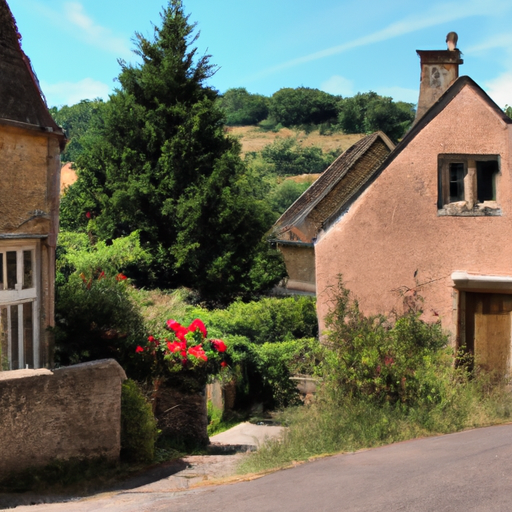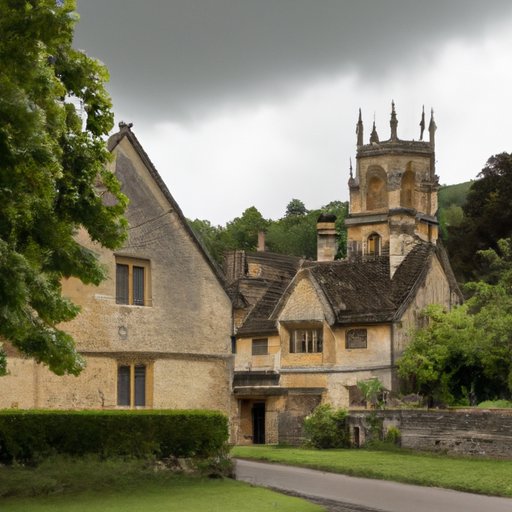If you’ve ever found yourself wondering about the picturesque destination known as the Cotswolds, you’re not alone. Nestled in the heart of England, the Cotswolds is a charming region renowned for its rolling hills, quaint villages, and stunning beauty. But where exactly are the Cotswolds located? Situated in the southwest and spreading across six picturesque counties, this enchanting area is easily accessible from major cities like London and Birmingham. So, if you’re in search of an idyllic English countryside escape, the Cotswolds might just be the perfect destination for you.

The Cotswolds: An Introduction
Introduction to the Cotswolds
Welcome to the Cotswolds! This beautiful and charming region in England is sure to captivate you with its stunning landscapes, fascinating history, and picturesque villages. Whether you’re a nature enthusiast, history buff, or simply seeking a relaxing getaway, the Cotswolds has something for everyone. From rolling hills and lush valleys to quaint market towns and traditional Cotswold villages, this area is a true gem waiting to be explored.
Geographical location of the Cotswolds
Nestled in the heart of England, the Cotswolds spans multiple counties, covering a considerable area that stretches approximately 800 square miles. With its central location within the United Kingdom, the Cotswolds offers easy access from major cities such as London, Birmingham, and Bristol. Its proximity to these urban centers makes it an ideal destination for a day trip or a weekend getaway.
Geography and Location
Location in the United Kingdom
Situated in south-central England, the Cotswolds is known for its stunning natural beauty and quintessentially English countryside. It is located between the counties of Gloucestershire, Oxfordshire, Warwickshire, Wiltshire, Worcestershire, and Somerset. The region’s diverse landscape encompasses rolling hills, expansive meadows, and hidden valleys, creating a scenic backdrop that is hard to resist.
Location in England
Within England, the Cotswolds is a treasure trove of natural splendor and rich heritage. It is typically classified as an Area of Outstanding Natural Beauty (AONB) due to its exceptional landscapes and geological features. The region spans from the northeastern corner of Somerset to the southeast of Worcestershire, covering parts of West Midlands, Oxfordshire, Warwickshire, and Gloucestershire.
Boundaries of the Cotswolds
The Cotswolds’ boundaries are not strictly defined but generally refer to the limestone hills that traverse the region. The area is loosely bounded by the River Avon to the west and the River Thames to the east. Oakley Hill in Worcestershire, Meon Hill in Warwickshire, and Alderton Hill in Gloucestershire are some of the key landmarks that define the Cotswolds’ boundaries.
Counties and Areas
Counties within the Cotswolds
The Cotswolds encompasses portions of several counties, each contributing to the region’s unique character and charm. Gloucestershire, Oxfordshire, and Warwickshire are the primary counties that make up the Cotswolds. Additionally, smaller portions of Wiltshire, Worcestershire, and Somerset are also included within this designated Area of Outstanding Natural Beauty.
Key areas within the Cotswolds
Within the Cotswolds, there are numerous distinctive areas that merit exploration. Some notable ones include the North Cotswolds, famous for its timeless villages and rolling hills; the South Cotswolds, renowned for its charming market towns and picturesque landscapes; and the Cotswolds Edge, offering breathtaking views over the Severn Valley. Each area has its own distinct appeal and offers a variety of attractions and activities for visitors to enjoy.
Historical Background
History of the Cotswolds
The Cotswolds has a rich and fascinating history dating back thousands of years. The region’s name is derived from “Cotswold Wolds,” where “wolds” means rolling hills. During the medieval period, the Cotswolds were prosperous due to the wool trade, with the area’s abundant sheep providing the raw material for the thriving industry. The region’s historic importance can be traced back to the Roman period, as evidenced by the remains of villas and Roman settlements scattered throughout the area.
Importance of the Cotswolds in history
As a testament to its historical significance, the Cotswolds is home to numerous historic sites and landmarks that offer insights into the region’s past. Ancient hill forts, such as Belas Knap and Uley Bury, provide glimpses into the area’s prehistoric origins. Medieval churches, manor houses, and Tudor cottages showcase the architectural heritage of the Cotswolds and its prominent role in shaping English history.

Natural Beauty and Landscape
Picturesque landscapes
A true haven for nature lovers, the Cotswolds boasts some of the most picturesque landscapes in England. From sweeping vistas of rolling hills blanketed in vibrant greenery to tranquil meadows dotted with wildflowers, every corner of this region is a feast for the eyes. The timeless beauty of the Cotswolds is further enhanced by its charming villages and historic market towns, which blend harmoniously into the landscape.
Hills and valleys
The Cotswolds is renowned for its enchanting hills and valleys, offering breathtaking views and countless opportunities for exploration. The Cotswold Hills, spanning over 100 miles, dominate the landscape and provide a stunning backdrop to the surrounding countryside. The valleys, such as the Painswick Valley and the Windrush Valley, add depth and character to the region, creating a diverse and captivating terrain.
Flora and fauna
The Cotswolds is teeming with an array of plant and animal life, making it a paradise for nature enthusiasts. The rolling hills and meadows are adorned with colorful wildflowers, including orchids, primroses, and rare native species. The area is also home to a variety of wildlife, including a thriving bird population, butterflies, and mammals such as foxes, badgers, and deer. Exploring the Cotswolds provides ample opportunities to immerse yourself in the region’s natural wonders.
Historic Market Towns and Villages
Unique market towns
The Cotswolds is famous for its charming market towns, each with its own distinct character and history. Stroll through the bustling streets of towns like Chipping Campden, Burford, and Cirencester, and you’ll be transported back in time. With their medieval architecture, antique shops, and local produce markets, these towns offer a glimpse into the past while providing modern-day amenities and a warm welcome.
Traditional Cotswold villages
The Cotswold villages are perhaps the most iconic feature of this delightful region. With their honey-colored stone cottages, thatched roofs, and well-tended gardens, these villages exude a timeless charm that is hard to resist. Explore the idyllic villages of Bibury, Bourton-on-the-Water, and Castle Combe, and you’ll understand why they have been cherished by locals and visitors alike for centuries. The Cotswolds’ villages offer a serene escape from the hustle and bustle of modern life.

Architectural Heritage
Distinctive Cotswold architecture
The Cotswolds is renowned for its distinctive architectural style, characterized by buildings crafted from the local Cotswold stone. This golden limestone gives the structures a warm and inviting glow, adding to the region’s overall charm. The buildings often feature steep gabled roofs, mullioned windows, and ornate doorways, showcasing the craftsmanship and attention to detail that defines the Cotswold architectural heritage.
Honey-colored stone buildings
One of the most captivating aspects of the Cotswolds is the prevalence of honey-colored stone buildings that line the streets of its towns and villages. This unique limestone, quarried from the local area, has been used for centuries, imparting a sense of continuity and harmony to the region’s architecture. The combination of the stone’s warm hues and the timeless designs of the buildings creates a visually stunning and cohesive backdrop throughout the Cotswolds.
Tourism and Attractions
Popular tourist destinations
The Cotswolds is a top destination for visitors from around the world, and it’s easy to see why. The region offers a multitude of attractions and activities to suit all interests. For history enthusiasts, the ancient Roman baths in Bath and the grand Blenheim Palace are must-see sites. Nature lovers can explore the breathtaking countryside on foot or by bike, and families can enjoy the magic of attractions like Cotswold Wildlife Park and Gardens. The Cotswolds truly has something to offer every traveler.
Outdoor activities
With its vast expanses of unspoiled countryside, the Cotswolds is a paradise for outdoor enthusiasts. Hiking and cycling are popular activities, with numerous trails and routes available to explore. The Cotswold Way, a long-distance walking trail, offers stunning views and the chance to traverse the region’s most scenic areas. For those seeking a more leisurely pace, picnicking by a tranquil river or enjoying a boat trip along the Thames can be the perfect way to unwind and connect with nature.
Museums and historic sites
Immerse yourself in the rich history of the Cotswolds by visiting its many museums and historic sites. The Corinium Museum in Cirencester provides a fascinating insight into Roman life in the area, while Sudeley Castle in Winchcombe offers a glimpse into medieval and Tudor times. Other notable sites include Snowshill Manor, Broadway Tower, and Chastleton House. Whether you’re a history buff or simply curious about the region’s past, the Cotswolds’ museums and historic sites are captivating destinations.

Transportation and Access
Road networks
Exploring the Cotswolds by car is a popular option due to its excellent road network. Major roads such as the M4 and M5 provide convenient access to the region, while well-maintained country lanes connect the towns and villages within the Cotswolds. Driving allows you to freely explore the remote corners of the area, uncovering hidden gems and scenic viewpoints along the way.
Public transportation
For those without access to a car, public transportation offers a convenient way to navigate the Cotswolds. Regular train services connect the area to major cities, with stations in popular towns such as Cheltenham, Oxford, and Moreton-in-Marsh. Buses and local transport services operate within the Cotswolds, providing easy access to attractions and villages. Whether by train or bus, public transportation ensures that the Cotswolds is accessible to all visitors.
Nearest airports and railway stations
The Cotswolds is well-connected to both domestic and international destinations. The nearest airports to the region include Bristol Airport, Birmingham Airport, and London Heathrow Airport. Each airport offers a range of flights to various destinations, making it easy for visitors to access the Cotswolds from around the world. Furthermore, nearby railway stations, such as Cheltenham Spa, Kemble, and Evesham, provide convenient travel options for those arriving by train.
Famous Cotswolds Events
Annual festivals and events
Throughout the year, the Cotswolds hosts a variety of annual festivals and events that showcase the region’s cultural and creative spirit. The Cheltenham Literature Festival, one of the world’s oldest and most prestigious literary festivals, attracts renowned authors and intellectuals from around the globe. The Cotswold Olimpick Games in Chipping Campden is a quirky and traditional event that celebrates local sports and activities. These festivals and events offer a glimpse into the vibrant and lively community spirit of the Cotswolds.
Cultural and historical celebrations
The Cotswolds is steeped in history and tradition, and this is reflected in its cultural celebrations. The Royal International Air Tattoo, held at RAF Fairford, showcases spectacular aerial displays and celebrates the region’s aviation heritage. Traditional events such as the Giffords Circus, featuring acrobatics, comedy, and equestrian performances, offer a taste of the Cotswolds’ unique entertainment. Whether you’re interested in aviation, the arts, or simply immersing yourself in the local traditions, the Cotswolds has an event to pique your interest.
In conclusion, the Cotswolds is a captivating region that combines natural beauty, rich history, and quaint charm to create a truly extraordinary experience. Whether you’re exploring the rolling hills and valleys, wandering through historic market towns and picturesque villages, or immersing yourself in the area’s architectural heritage, the Cotswolds offers something for everyone. With its easy accessibility and diverse range of attractions and activities, this beloved corner of England is a destination well worth visiting. So pack your bags, embrace the friendly atmosphere, and embark on an unforgettable journey through the Cotswolds.

